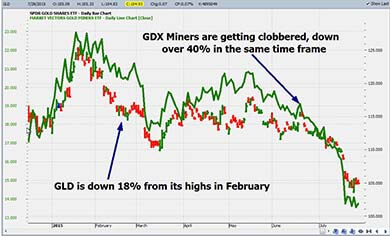I love gold right now, not despite, but because of everything that's happened to it this month...
Now, it's true that the "race to $1,000" triggered by the July 20 Asian bear raid appears to have the yellow metal on the ropes.
Television's talking heads (plenty of whom are actually short gold) say that it's "too early to call a bottom," or that gold "has the potential to sink to $700."
Now, I don't expect another 35% dip in gold, but even if they're right, those television pundits are still missing out on one of the year's most lucrative gold opportunities taking shape now.
They're just not seeing what I'm seeing in these charts.
Have a look at this...
Miners Are Plunging Faster Than Gold Itself
The SPDR Gold Trust ETF (NYSE Arca: GLD) is one of the most popular gold exchange-traded funds because it's one of a few that actually own physical gold.
It's been dropping since February, from highs of more than $125 to recent lows of around $105.
That's an 18% drop, but that's nothing compared to the miners.
The Market Vectors Gold Miners ETF (NYSE Arca: GDX) tracks a "basket" of gold mining companies, and it's down more than 40% since February.

Click to Enlarge
And there you have it: Miners are getting clobbered much more than the physical metal.
There's a very interesting reason for this...
It's all about earnings, or in this case, the critical lack of them.
You see, the cost of equipment, labor, and production gives these companies a good idea of what it will cost to mine an ounce of gold.
No matter if gold rises or falls, companies' mining costs remain the same. So unless miners are hedging (selling) tomorrow's gold with today's prices, they're more reactive to the price swings in gold.
As gold rises, the miners see more significant gains. As gold bottoms, playing the miners may make far more sense.
There's a huge value bid in the drop here...
There's a Good Play... and There's the Best Play
We can use options to hedge our risk and take advantage of the potential in this odd relationship I've uncovered.
One approach would be GDX January 2016 $12 calls (GDX160115C00012000) for the cost of $262 per contract. That's a small amount when comparing the contract to 100 shares of stock at the current price of $13.69 for $1,369.
But buying this option, you really need the stock to move over 5 points to double in value. That's a 25% move in GDX. We're actually looking for about half that move.
And that brings me to the best strategy - the spread, or "loophole," strategy...
In this strategy, we're still buying the same GDX January 2016 $12 calls (GDX160115C00012000), but we're also selling the GDX January 2016 $15 calls (GDX160115C00015000) to lower the cost of the overall trade.
Creating this call spread, the cost of the trade now falls to $139, nearly half of the cost of the open call.
And it gets better...
If GDX is at $15 by the January expiration, we could see as much as a 115% return!
That's right - we're still getting better than a double, but we need much less movement on the underlying stock.
Our "loophole" spreads make it easy (and affordable) to get bullish or bearish, and they can also increase returns with much smaller moves on the underlying stock. That's why they're one of my favorite trades.
Claim your no-cost subscriptions to Tom's Power Profit Trades and get lucrative money-doubling opportunities like this one twice each week. Just click here to sign up...
About the Author
Tom Gentile, options trading specialist for Money Map Press, is widely known as America's No. 1 Pattern Trader thanks to his nearly 30 years of experience spotting lucrative patterns in options trading. Tom has taught over 300,000 traders his option trading secrets in a variety of settings, including seminars and workshops. He's also a bestselling author of eight books and training courses.





